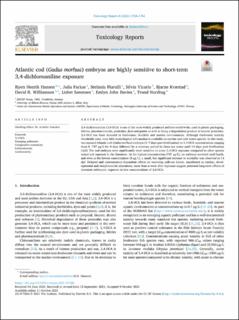Atlantic cod (Gadus morhua) embryos are highly sensitive to short-term 3,4-dichloroaniline exposure
| dc.contributor.author | Hansen, Bjørn Henrik | |
| dc.contributor.author | Farkas, Julia | |
| dc.contributor.author | Piarulli, Stefania | |
| dc.contributor.author | Vicario, Silvia | |
| dc.contributor.author | Kvæstad, Bjarne | |
| dc.contributor.author | Williamson, David Roddan | |
| dc.contributor.author | Sørensen, Lisbet | |
| dc.contributor.author | Davies, Emlyn John | |
| dc.contributor.author | Nordtug, Trond | |
| dc.date.accessioned | 2021-11-03T12:57:43Z | |
| dc.date.available | 2021-11-03T12:57:43Z | |
| dc.date.created | 2021-10-20T22:20:03Z | |
| dc.date.issued | 2021 | |
| dc.identifier.citation | Toxicology reports. 2021, 8 1754-1761. | en_US |
| dc.identifier.issn | 2214-7500 | |
| dc.identifier.uri | https://hdl.handle.net/11250/2827626 | |
| dc.description.abstract | 3,4-dichloroaniline (3,4-DCA) is one of the most widely produced anilines world-wide, used in plastic packaging, fabrics, pharmaceuticals, pesticides, dyes and paints as well as being a degradation product of several pesticides. 3,4-DCA has been detected in freshwater, brackish and marine environments. Although freshwater toxicity thresholds exist, very little toxicological information is available on marine and cold-water species. In this study, we exposed Atlantic cod (Gadus morhua) embryos (3–7 days post fertilization) to 3,4-DCA concentrations ranging from 8−747 μg/L for 4 days followed by a recovery period in clean sea water until 14 days post fertilization (dpf). The cod embryos were significantly more sensitive to acute 3,4-DCA exposure compared to other species tested and reported in the literature. At the highest concentration (747 μg/L), no embryos survived until hatch, and even at the lowest concentration (8 μg/L), a small, but significant increase in mortality was observed at 14 dpf. Delayed and concentration-dependent effects on surviving yolk-sac larvae, manifested as cardiac, developmental and morphometric alterations, more than a week after exposure suggest potential long-term effects of transient embryonic exposure to low concentrations of 3,4-DCA. | en_US |
| dc.language.iso | eng | en_US |
| dc.publisher | Elsevier | en_US |
| dc.rights | Navngivelse 4.0 Internasjonal | * |
| dc.rights.uri | http://creativecommons.org/licenses/by/4.0/deed.no | * |
| dc.title | Atlantic cod (Gadus morhua) embryos are highly sensitive to short-term 3,4-dichloroaniline exposure | en_US |
| dc.type | Peer reviewed | en_US |
| dc.type | Journal article | en_US |
| dc.description.version | publishedVersion | en_US |
| dc.source.pagenumber | 1754-1761 | en_US |
| dc.source.volume | 8 | en_US |
| dc.source.journal | Toxicology reports | en_US |
| dc.identifier.doi | 10.1016/j.toxrep.2021.10.006 | |
| dc.identifier.cristin | 1947447 | |
| dc.relation.project | Norges forskningsråd: 280511 | en_US |
| cristin.ispublished | true | |
| cristin.fulltext | original | |
| cristin.qualitycode | 1 |
Files in this item
This item appears in the following Collection(s)
-
Institutt for marin teknikk [3406]
-
Publikasjoner fra CRIStin - NTNU [37247]

